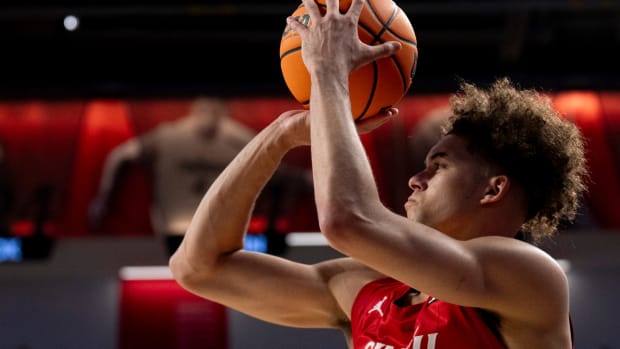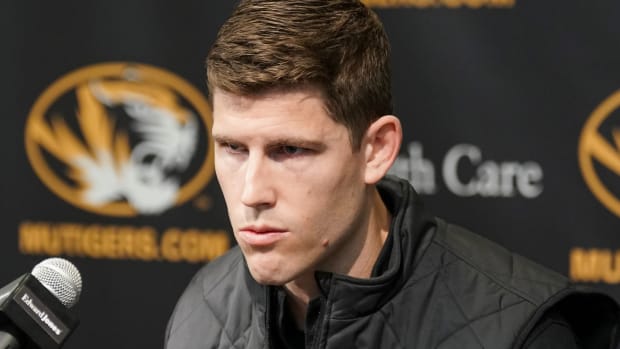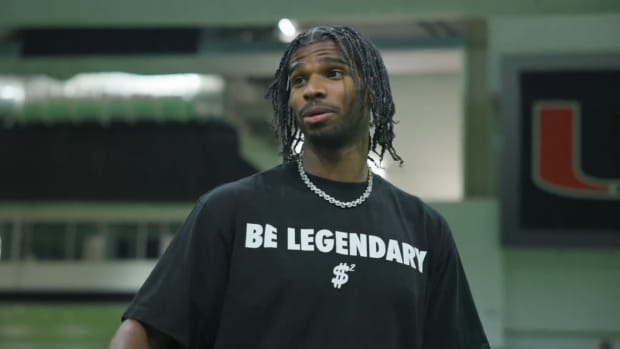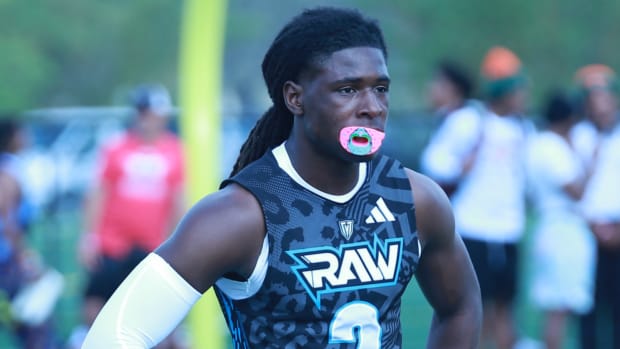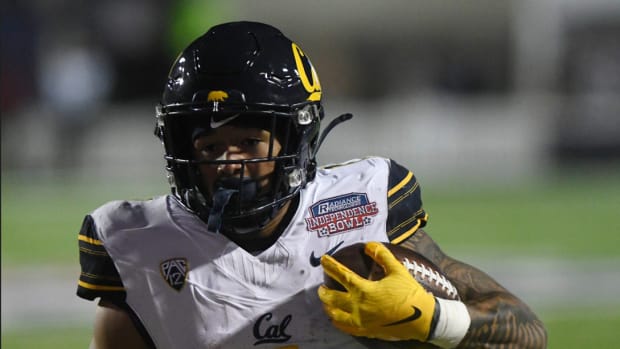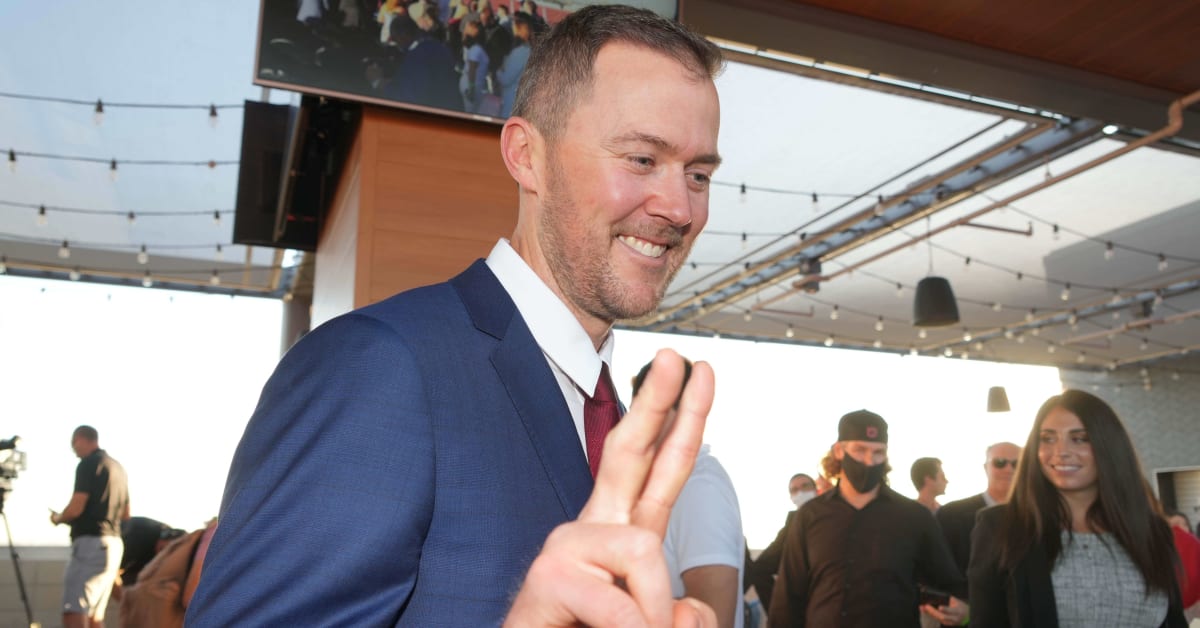
‘It’s Ready to Explode’: Lincoln Riley’s Move to USC Already Making Waves in Los Angeles
LOS ANGELES — For everyone fussing about cultural fit, Lincoln Riley left evidence right out in the open months ago that it was going to work out just fine. Check his Twitter account from May 21, 2021, when then-Oklahoma football coach Riley posted video of himself surfing with his daughter, Sloan.
He might not be ready to ride the big rollers at The Wedge at Newport Beach. Not yet. But a guy who grew up in Muleshoe, Texas, and spent most of his adult life in Lubbock and Norman really can relocate to Los Angeles and USC. He can exchange cowboy boots for flip-flops without losing stride.
“Pretty normal path, right?” Riley joked with Sports Illustrated last week. “It will be different, but I’ve told people I have a life’s-too-short mentality. Go experience it. My family has always loved the West Coast. The chance to raise our kids out here is a great opportunity.”
The wave of enthusiasm Riley is riding now is a sporting tsunami. One of the most audacious coaching moves in college football history is still gaining momentum, with a fresh surge Tuesday. That’s when Riley’s star quarterback at Oklahoma, Caleb Williams, finally announced that he’s following his coach to USC.
This was a recruiting score built very much out of 2022 pieces—the ability to marshal resources and present compelling Name, Imagine and Likeness (NIL) opportunities, plus the immediate transfer eligibility that has made rapid roster remodeling possible. In both those areas, the Trojans, with their rich donor reservoir and L.A. connections to entertainment and business, are positioned to win big. “USC can leverage the power of the market it’s in,” says one industry insider familiar with the school’s NIL plans. “There’s a whole world they can tap into.”
All last week, USC staffers maintained Cheshire Cat countenances when the subject of Williams arose. The excitement was contained, barely, while waiting for things to play out on the quarterback’s meandering timetable. Now that Williams is on campus and enrolled, the euphoria is out in the open and Riley’s National Letter of Intent signing day press conference on Wednesday should reflect that.
“This is exactly the type of buzz, energy and passion we need,” athletic director Mike Bohn says. “I’m a big believer that energy wins. And we’ve got it right now.”
While Williams’s transfer sent another spasm of bitterness through jilted Sooners fans—some of whom now refer to Riley in internet shorthand as TBOW, or That B---- Out West—it capped off two months of sustained euphoria for the Trojans. The talent riding Riley’s coattails into L.A. is dazzling, which is exactly what USC envisioned when he was hired but perhaps did not expect quite this quickly.
A day after Mississippi coach and Twitter wiseacre Lane Kiffin crowned himself king of the transfer portal, he voluntarily relinquished that title to Riley. “We can transfer that to him,” said Kiffin, whose coup landing USC QB transfer Jaxson Dart was made possible by the fact that Riley was bringing in the bigger prize in Williams.
That pushed the Trojans to the top of the latest recruiting metric in the shifting world of college football, the 247Sports transfer portal rankings. USC already was crushing the portal, having added Oregon running back Travis Dye (nearly 4,000 career yards from scrimmage), another pair of Sooners in receiver Mario Williams and cornerback Latrell McCutchin, and several others who could have immediate impact.
On the high school front, Riley has procured a small but talented cast of 2022 prospects and gotten a big start on ’23, again plundering Oklahoma for a pair of five-star recruits who had initially committed there. Both Malachi Nelson and Makai Lemon are Southern California kids now prepared to stay home, as the new USC staff criss-crosses the area to slow the talent exodus that helped leave a proud program in disrepair. The Trojans are trying to end an era when a local star like Bryce Young was a regular at USC practice and then signed with Alabama.
“Just about everyone we come across has some sort of tie or investment level in the program,” Riley says. “Gosh, it’s unique. I do think there’s a real sense of pride in this city about USC football.
“You feel how eager people are to see USC on top again. You feel like it’s ready to explode. It’s primed.”
The flight from Oklahoma to Los Angeles on USC Board of Trustees chair Rick Caruso’s private jet lasted about 2 1/2 hours. It was one long personnel meeting, and the time flew by. This was a two-minute drill of an introduction to Trojans football.
Bohn, his chief of staff, Brandon Sosna, and football player personnel director Spencer Harris were in the USC travel party that picked up Riley on the afternoon of Nov. 28. They came with binders full of information on the roster Riley was inheriting—full breakdowns by position and class—plus an organizational chart and an overview of the recruiting board as it stood at the time.
The principals involved had never met face-to-face until that flight. There was a Zoom call that morning to get acquainted and go over the whopping offer being presented to Riley—that virtual meeting was the preferred method of communication to keep flight trackers off their trail as long as possible. The Zoom call came together after Riley had returned in the wee hours to Norman from Stillwater, where his Sooners had lost to rival Oklahoma State and been eliminated from the Big 12 championship game.
After that game, Riley carefully chose his words in cutting off a question about “all the rumors” that had swirled during the week leading up to the game. “I’m not going to be the next head coach at LSU,” Riley said, shooting down the most prominent rumor of the week. That sent the news cycle spinning in Louisiana, but it clearly did not tell the whole story.
To say that Oklahoma officials were caught off guard that Sunday would be an understatement. Whatever is past stunned begins to get in the neighborhood of their reaction. A program insider voiced frustration to Sports Illustrated that week about the persistent rumors about Riley, saying that the same speculation surrounded previous coach Bob Stoops for years and he never took another job. “Why do people say that about our coaches and not Ohio State or Alabama, when our coaches have always stayed?” the insider asked.
Five days later, Riley was in Los Angeles.
The coach and Bohn both told SI they did not want to answer questions about Oklahoma or the particulars of Riley’s departure. “I don’t think it’s important to get into specifics,” Bohn says. “We’re moving forward.”
The rationale there likely is twofold. For one, Riley has no interest in further stirring up hurt feelings. Additionally, the timeline of communication between the school and Riley’s representatives might have been longer and more muddled than anyone would like to acknowledge. (Riley’s agent, Trace Armstrong, did not respond to an interview request for this story.)
But a source familiar with the USC hiring process did say that Oklahoma’s future move to the Southeastern Conference along with fellow Big 12 lynchpin Texas, a bombshell that dropped last summer, was a factor in Riley’s willingness to look elsewhere. “I don’t think the SEC fit was particularly enticing or popular,” the source said.
It wasn’t long after that development that USC officially moved into the hiring market. When the Trojans were blown out by a bad Stanford team in the second game of the season, Bohn ended Clay Helton’s tenure after 70 games. That gave the school a long runway to find its next coach, part of a deliberate approach to rehabbing a dilapidated blueblood program.
Bohn’s hiring by president Carol Folt in November 2019 was a significant step toward a more professional athletic department. Bohn was the first administrator with AD experience that the school had brought onboard in decades, after a succession of nostalgia football-hero hires—Mike Garrett, Pat Haden, Lynn Swann—left the program dealing with NCAA sanctions and lagging in modern infrastructure. Bohn arrived from Cincinnati, with Sosna in tow, and the two began a full assessment of strengths and weaknesses.
“We were behind,” Bohn says. “Behind on technology, support staff, food and nutrition elements, professional growth opportunities for players, taking advantage of what a USC education can do. Clay helped identify those things.”
Helton was not a coach of championship caliber, but taking over late in the 2019 season didn’t give Bohn sufficient time to make that assessment and arrive at a quick-trigger solution. That led to giving him the 2020 season, and after the pandemic turned that into a six-game minischedule and a major drain on income, Helton survived again into 2021.
Fans fumed, but this was valuable time needed to get USC’s house in order for a transformational hire. By the 2021 season, major improvements had been made in terms of staff and amenities. The fabled L.A. Coliseum had gotten a facelift. University leadership was onboard with a Whatever It Takes approach to reviving the football product.
At the first sign of weakness in September, Helton was fired and the hunt for big game had begun. Outside the program, few people believed Riley was a realistic target. Inside, he was always the target.
Bohn and Sosna had three tiers of prospects and vetted dozens of candidates. But above them was “Tier Zero,” a list of about five superstar candidates that, if they showed interest, would be pursued with utmost ardor. Riley, a 38-year-old offensive savant who took Oklahoma to the College Football Playoff three times in five seasons and churned out NFL quarterbacks, was the No. 1 candidate on the Tier Zero list.
“There’s not a lot of naturally smart people in the coaching world,” says one industry insider. “He’s naturally brilliant.”
Media speculation focused elsewhere, to the delight of USC administrators. The more speculation surrounded Penn State’s James Franklin or Cincinnati’s Luke Fickell or Notre Dame’s Brian Kelly, the more USC could operate outside of the spotlight.
For a place that often sprang confidentiality leaks in previous years, USC was notably buttoned up this time. That was even more remarkable given the length of the search, as it spanned nearly three full months. Bohn credits that to lessons learned working years earlier for search firm head Chuck Neinas. “Watching him help hire Urban Meyer from Utah to Florida or Mack Brown from North Carolina to Texas, the constant there was confidentiality,” Bohn says.
That confidentiality extended up the food chain to Folt and Caruso, the board chair. The buzzword in college coaching is “alignment,” and the Trojans needed it to make this search operate smoothly. Fewer people in the know and fewer voices adding their input expedited the process. "This time it was easy for us to be aligned, because Lincoln is who we all wanted," Folt says. "It just clicked."
To make that happen, Bohn also had to win over the trust and support of fans and donors. The first two years on the job helped establish that foundation as well, establishing relationships—and then, somewhat paradoxically but importantly, pushing some of those people away during the search.
“The biggest concern in a lot of these searches is interference from donors, former players, current players, people on social media,” says a source with knowledge of the USC search. “USC had zero. They had all the latitude they needed for their one shot.”
As the season progressed, everything was aligning for USC to have its shot with Riley. But the timing in the 11th hour was critical, and Trojans brass sitting in a Coliseum suite on the night of Nov. 27th was sweating out the results of a game some 1,400 miles away.
While the Trojans were playing BYU, the TV in Bohn’s suite was tuned to that Oklahoma-Oklahoma State game. If the Sooners won, they would advance to the Big 12 title game and—at best—delay USC’s pursuit of Riley. If Oklahoma made the title game, won it, and advanced to the playoff, that would probably kill the chase.
The Sooners took a nine-point led into the fourth quarter before Oklahoma State rallied to win. Bohn and Sosna exhaled, then took aim for their one shot.
Riley was receptive to being the target. Late-night phone calls led to that morning Zoom call, which led to another flurry of phone activity as Caruso’s jet was readied for takeoff. When the the plane landed in Oklahoma on that November Sunday, Lincoln Riley was ready to get on it and make one of the biggest powerhouse-to-powerhouse moves in college football history.
Upon arrival in L.A., Riley was gifted with a rare opportunity to spend a week watching his future team play a final regular-season game. As the Trojans prepared to play a rescheduled contest against California and then muddled through a 24–14 defeat, the new coach was studying his players. Bringing a lot of staff with him from Oklahoma helped in the appraisal.
“That was huge,” Riley says. “We had three basic categories of players: guys who are completely bought in and excited to have the ability to perform at the level we expect; a couple guys where the culture doesn’t fit; and a couple guys from a skill-set standpoint that weren’t the best fit.
“We had to be up-front and direct with them, give them honest feedback. I think we’ve got the roster in a good place and we’ve got a lot of roster flexibility.”
As of last week, Riley estimated that he has a whopping 35 spots available. That presents a challenge in blending that many newcomers together. It’s also one reason why the Trojans have been so busy in the portal (and could remain busy there into August, Riley says).
That kind of churn can happen after years of atrophy. Offensive line and the entire defense are of particularly acute concern, and could be the biggest impediments to quickly spinning the program around 180 degrees from a 4–8 season in 2021.
But the expectations are rising, and Riley isn’t going to be the one to tamp them down now. “Nobody came in here to get on a long-term rebuild,” he says.
What began with a surfing analogy can appropriately end with one, this time courtesy of Bohn. Having landed the Big Kahuna, he wants to help the man shred.
“If you go out to our beaches in Los Angeles, those waves keep coming in,” Bohn says. “We want to keep those waves coming in strong and allow Lincoln to surf on those high tides. Last time I checked, those waves are still going.”
More College Football Coverage:
• College Football Way-Too-Early Top 25 for 2022
• The Fight Over the Future of College Sports Is Here
• Stetson Bennett's Resolve Keys Georgia's National Title
• How Kirby, Georgia Finally Broke Through to Win It All


